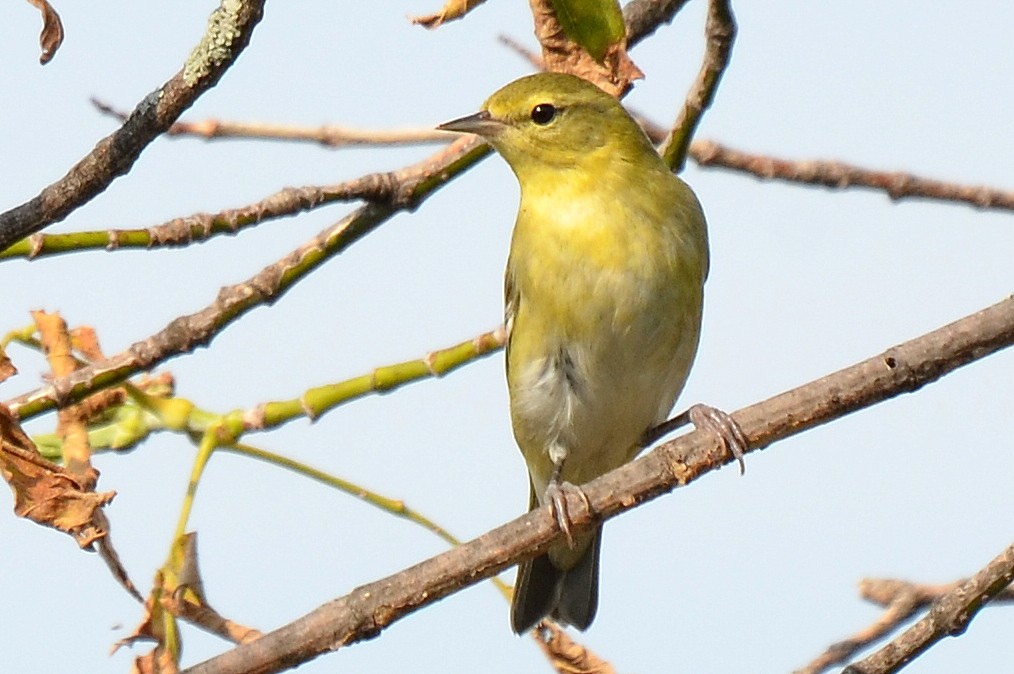Tennessee Warbler
A species of Leiothlypis Warblers Scientific name : Leiothlypis peregrina Genus : Leiothlypis Warblers
Tennessee Warbler, A species of Leiothlypis Warblers
Botanical name: Leiothlypis peregrina
Genus: Leiothlypis Warblers
Content
Description People often ask General Info
Description
The Tennessee warbler is 11.5 cm (4.5 in) long, has a 19.69 cm (7.75 in) wingspan, and weighs roughly 10 g (0.35 oz). The breeding male has olive back, shoulders, rump and vent. The flight feathers are brownish-black. It has a slate gray neck, crown and eyeline. The underside is a gray-white. The female is similar to the male, but is much duller and has a greener tinge to the underside. The Tennessee warbler has long wings, short tail and a thin, pointy bill. Juveniles and first-year birds are quite similar to the female. Tennessee warblers resemble female black-throated blue warblers. The only difference is that the black-throated blue has a darker cheek and two white wing spots. This bird can be confused with the red-eyed vireo, which is larger, moves more deliberately and sings almost constantly. The orange-crowned warbler can also look similar, but lacks the white eyebrow, is greyer-brown above and has yellow undertail coverts. 
Size
12 cm
Colors
Brown
Black
Green
Gray
White
Life Expectancy
6 years
Nest Placement
Ground
Clutch Size
5 - 6 eggs
Incubation Period
1 brood
Number of Broods
11 - 12 days
Nestling Period
11 - 12 days
Feeding Habits
Tennessee Warbler predominantly forage for caterpillars and various invertebrates, often targeting spruce budworm outbreaks. Up to 90% of the diet for young may be caterpillars. Other insects, like beetles and flies, are also consumed. Seasonally, they eat fruits and un-pollinatingly extract nectar by piercing flower bases.
Habitat
The tennessee Warbler thrives in young to middle-aged boreal forests with a blend of coniferous and deciduous trees, and areas regenerating post-disturbance. It adapts to various altitudes and climates. During migration, tennessee Warbler uses groves and brush in eastern North America, while in winter, it frequents open or semi-open tropical forests, including citrus orchards and coffee plantations.
Nest Behavior
The timing of nest building by tennessee Warbler is in sync with their breeding season. Egg-laying patterns are consistent with many passerines, and parental care involves both parents in the incubation and feeding of the young, ensuring optimal survival and growth.
Nest Characteristics
Tennessee Warbler's nest is a well-concealed, cup-shaped structure typically situated near the ground in a sphagnum moss hummock or in the roots of a fallen tree. It features a two-layered construction with an outer layer of dead grass or weed stems and an inner lining of fine grasses, supplemented with hair or mosses.
Dite type
Insectivorous
People often ask
General Info
Feeding Habits
Bird food type
Bird Feeder Type

Small Hopper

Small Tube Feeder
Sounds
Call
Recording location: Costa Rica
Song
Recording location: United States
Song
Recording location: United States
Behavior
The tennessee Warbler is an energetic and social warbler, engaging in constant movement and foraging in forest canopies for invertebrates. They exhibit territorial behaviors during the breeding season, with males fervently protecting their space and providing for females during incubation. Although they do not typically engage in extra-pair mating, both parents are involved in nurturing their offspring. Outside of breeding, tennessee Warblers display a gregarious nature, often joining mixed-species flocks and sharing resources, though they can be defensive over nectar. Their unique adaptability is seen in their interaction with various habitats across seasons.
Distribution Area
The Tennessee warbler breeds from the Adirondack Mountains in New York through northern Vermont, New Hampshire, and Maine north and west throughout much of Canada. It is also found breeding in northeast Minnesota and northern Upper Peninsula of Michigan. It is migratory, wintering in southern Central America, the Caribbean, and northern Colombia and Venezuela, with a few stragglers going as far south as Ecuador. It is a very rare vagrant to western Europe. This bird was named from a specimen collected in Tennessee, where it may appear during migration. 
Species Status
Not globally threatened.
Scientific Classification
Phylum
Chordates Class
Birds Order
Perching birds Family
New world warblers Genus
Leiothlypis Warblers Species
Tennessee Warbler 